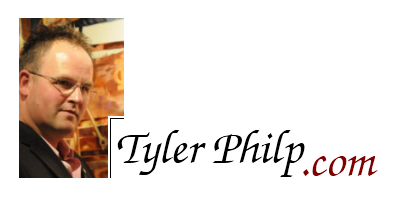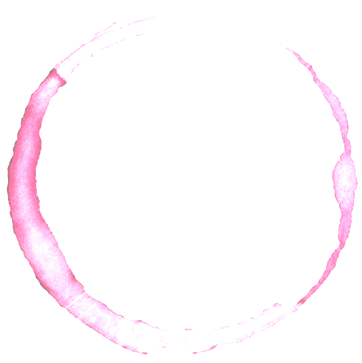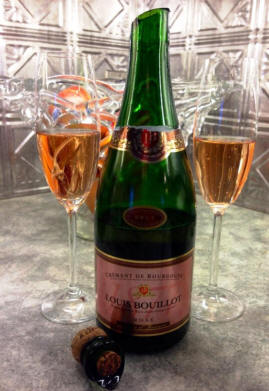
< Previous / Next >
 |
Article Index < Previous / Next > |

Champagne
- a tour of styles
While most people still reserve a glass of
Sparkling wine is made throughout the world, but the name
In accordance with the French
AOC (Appellation d’Origine Contrôlée
or governing wine authority),
only certain grape varieties are permitted in the production
of
· Chardonnay (white) – Finesse and Elegance
· Pinot Meunier (red) – Body and Richness
· Pinot Noir (red) – Fruitiness
The term Blanc-de-Blanc will appear on the label to indicate that
only Chardonnay was used in the making of the wine. And while less common, Blanc-de-Noirs signifies
when the wine is made using only Pinot Noir and/or Pinot Meunier, both
dark-skinned grapes.
· Brut (natural) is dry wine
· Sec (dry) is actually off-dry wine
· Demi-Sec (half dry) is slightly sweet wine
The term Brut implies a dry crisp wine, whereas Sec and Demi-Sec show
increasingly more sweetness and body. The vast majority of
Vintage vs. Non-Vintage 
Using a process known as assemblage,
Vintage
Delaying the run-off of the crushed grape juice (must) and separation
from the dark-skinned grapes such as Pinot Meunier and/or Pinot Noir will
result in a slight red stained wine – we know this as Rosé
In terms of cellaring potential,
When serving
“
Tyler's sparkling wine
and Champagne picks
Segura Viudas Brut Reserva Cava
Spain
Just look at the price!! Spanish goodness made using the same technique as
Champagne. If you normally drink cheap fizz for celebration, try this significantly better bubbly instead.
LCBO #216960 $14.25
Domaine Du Clos De L'epinay Tête De Cuvée Brut Vouvray 2007, Méthode
Traditionnelle
Loire, France
Amber coloured in the glass with a great depth of aroma and flavour. We
sipped this one on Christmas day with much hooray! .
LCBO #298398 $20.95
Cave Spring Blanc de Blancs Brut
Ontario, Canada
No black grapes were harmed in the making of this sparkling wine; Blanc de
Blanc means ‘white of whites’ and includes only Chardonnay. This example is
not only local, but exceptional quality as well.
LCBO #213983 $27.95
Domaine Chandon Étoile Brut
California, USA
From the makers of French famed Dom Perignon, Moet et Chandon, this is a
warm climate edition that won’t disappoint.
LCBO #205658 $39.95
Devaux Cuvée Rosée Brut Champagne
Champagne, France
A Traditional Champagne that is not only stunningly enjoyable to drink, but
also shimmers in the light with a lovely rose coloured tint – perfect to sip
as the big apple drops!
LCBO #352211 $59.95
Red & White for the appetizers
Nerderburg, Winemaster’s Reverve, Saivignon Blanc 2013
South Africa
A medium bodied, crisp, grassy, curiously dill-herbed mouthful of South
African goodness. Considering the varietal character involved, I'm rather
thrown off by the price. This Western Cape jem will pair perfectly with
shellfish appetizers or baked Brie and other cream based cheeses over the
holidays.
LCBO #382713 $11.45
Vieil Armand Grand Cru Ollwiller Riesling 2009, Grand Cru
Alsace, France
A touch of sweetness initially and a fantastic weight on the palate; notes
of apricot, beeswax and spice to finish. An outstanding French Riesling,
though it is getting hard to come by on the store shelves.
LCBO #315135 $20.95
Farnese Daunia Sangiovese 2009
Abruzzo, Italy
Someone once told me that when the fancy $$$ red bottles are empty at ritzy
Rosedale functions, they refill them with Farnese and no one can tell the
difference... fact or fiction, you decide – but this is a very good bottle
of wine and for the money, simply an unbeatable deal. Expect a smooth,
medium bodied feel with lots of red fruit and a touch of tannin to pair with
a variety of dried meats, olives, and the cheese tray.
LCBO #512327 $7.50, yes $7.50
Montecillo Crianza 2008
Rioja, Spain
A lightly oaked mouth-watering Tempranillo-based Spanish red with food
pairing potential extrordinare!
LCBO #144493 $13.95
How to open a bottle of bubbly with style - Champagne
Sabreing video
return to the Article Index |
||
Tyler Philp is a member of the Wine Writers' Circle of Canada Please direct inquires for writing services to: info@tylerphilp.com |
||
| Copyright © 2013 Tyler Philp
prior permission required for duplication of material |
||